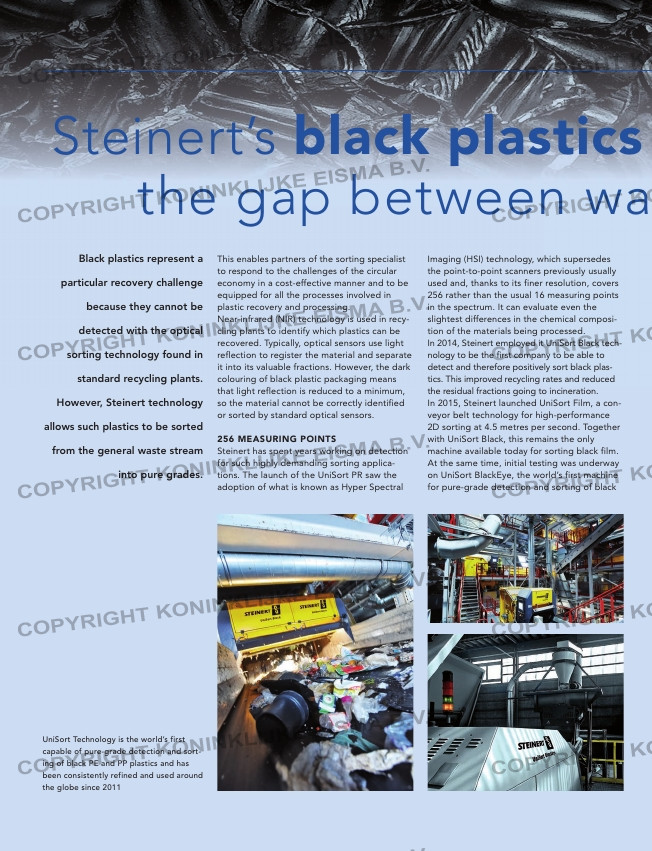Page 50 from: West Coast report + Plastics Special

Steinert’s black plastics sorting technology closes
the gap between waste and new products
Black plastics represent a
particular recovery challenge
because they cannot be
detected with the optical
sorting technology found in
standard recycling plants.
However, Steinert technology
allows such plastics to be sorted
from the general waste stream
into pure grades.
This enables partners of the sorting specialist
to respond to the challenges of the circular
economy in a cost-effective manner and to be
equipped for all the processes involved in
plastic recovery and processing.
Near-infrared (NIR) technology is used in recy-
cling plants to identify which plastics can be
recovered. Typically, optical sensors use light
reflection to register the material and separate
it into its valuable fractions. However, the dark
colouring of black plastic packaging means
that light reflection is reduced to a minimum,
so the material cannot be correctly identified
or sorted by standard optical sensors.
256 MEASURING POINTS
Steinert has spent years working on detection
for such highly demanding sorting applica-
tions. The launch of the UniSort PR saw the
adoption of what is known as Hyper Spectral
Imaging (HSI) technology, which supersedes
the point-to-point scanners previously usually
used and, thanks to its finer resolution, covers
256 rather than the usual 16 measuring points
in the spectrum. It can evaluate even the
slightest differences in the chemical composi-
tion of the materials being processed.
In 2014, Steinert employed it UniSort Black tech-
nology to be the first company to be able to
detect and therefore positively sort black plas-
tics. This improved recycling rates and reduced
the residual fractions going to incineration.
In 2015, Steinert launched UniSort Film, a con-
veyor belt technology for high-performance
2D sorting at 4.5 metres per second. Together
with UniSort Black, this remains the only
machine available today for sorting black film.
At the same time, initial testing was underway
on UniSort BlackEye, the world’s first machine
for pure-grade detection and sorting of black
polyethylene (PE), polypropylene (PP). It has
been used around the globe since 2016.
UniSort BlackEye is the most recent iteration
of Steinert’s HSI technology, which it has been
consistently refining since 2011.
PURE-GRADE SEPARATION
Plastic-processing companies in particular can
benefit from Steinert products and replace
polymer granulates with mint-condition recy-
clates. Even black polyolefins (PO), which are
hard to recycle, can be sorted into fractions
such as PE, PP, polystyrene (PS) and acryloni-
trile butadiene styrene copolymers (ABS) to a
level of quality approaching primary plastics.
UniSort BlackEye allows plastic waste contain-
ing a high proportion of black to be separated
on an industrial scale. It can then to be upgrad-
ed to a plastic granulate with properties similar
to those of the primary raw material to be used
in the manufacture of durable, quality products.
This procedure means that, today, a significant
percentage of new plastics can be replaced
with recycled materials, thereby saving hun-
dreds of thousands of tons of CO2 every year.
GERMANY’S LARGEST SITE RELIES ON NIR
In addition to working with the plastic process-
ing industry, Steinert also provides disposal
companies with solutions for their sorting tasks
and combines it with over 130 years of process
know-how. For example, Steinert enables the
Germany’s largest approved single site for
post-consumer packaging to respond to tight-
er packaging legislation which came into force
at the start of the year and to increase the pro-
portion of pure-grade plastics which can be
recycled: ‘Our partnership with Steinert has
been intensive and the right resources were
put in place to affectively handle the challeng-
ing task we faced. We quickly achieved our
goals. We managed this by gathering together
our strengths and so achieved rapid progress,’
says Christian Hündgen, general manager at
Hündgen Entsorgung.
UniSort Technology is the world’s first
capable of pure-grade detection and sort-
ing of black PE and PP plastics and has
been consistently refined and used around
the globe since 2011
50-51_steinert.indd 50 08-08-19 11:15



